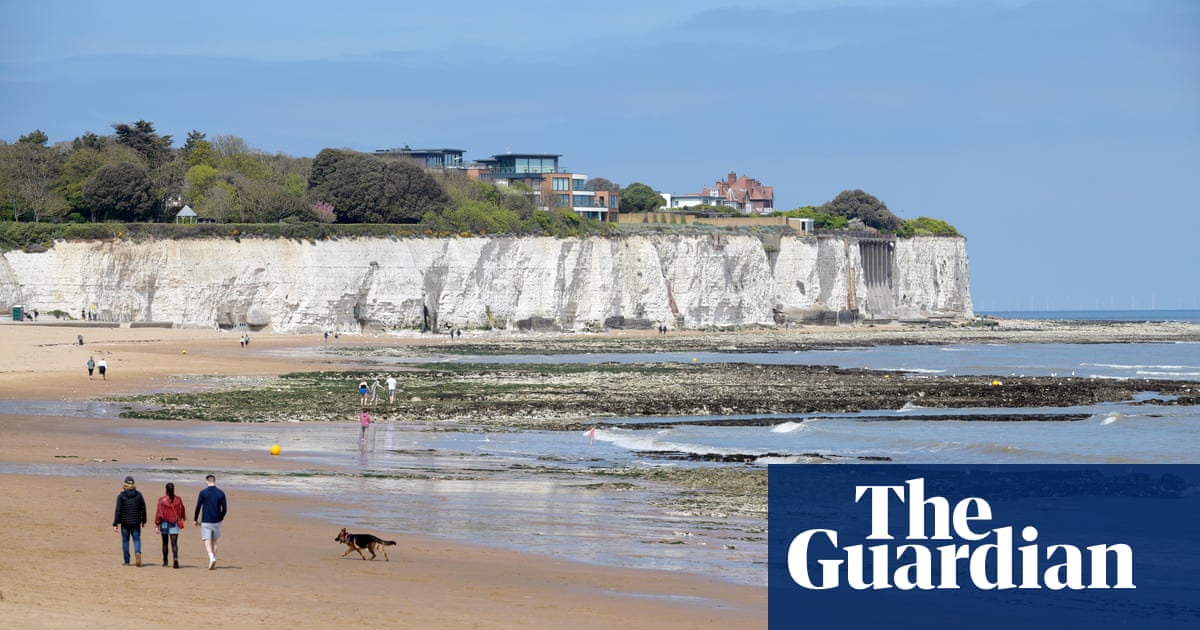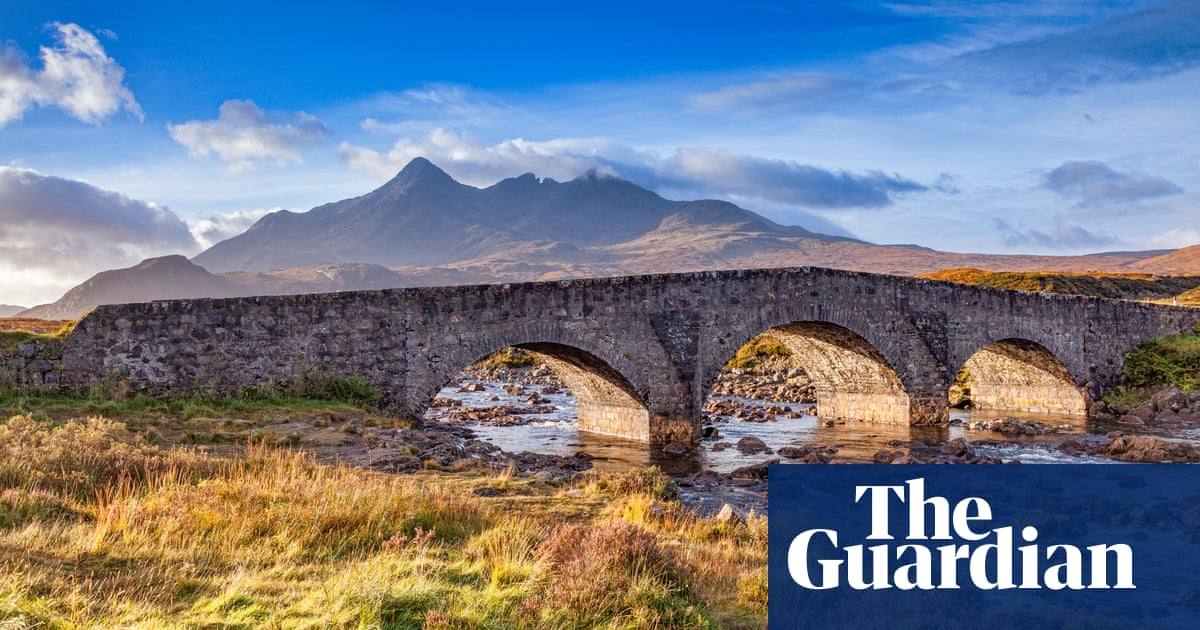
An hour after leaving London Blackfriars, the Thameslink train emerges from a long tunnel into a rural Kentish idyll. As we pass over a Victorian viaduct a bucolic view beckons from the south: a meandering river between wooded chalk hills. Water meadows, poplars and an ancient church tower complete the scene. It’s like a fleeting glimpse of a picture book showing the Garden of England. We have entered the Darent valley, which, despite being on London’s doorstep, offers several secluded walks – and more than a couple of great pubs.
Shoreham is a hub for many hiking routes, but when the train pulls in, a smartly dressed group disembark alongside us, none of them wearing walking boots. They’re heading into the village for stone-baked pizzas and wine at the Mount Vineyard. The vineyard team has also taken over the 15th-century Ye Olde George inn and, after a thorough and tasteful revamp, reintroduced it to the world in April as the Samuel Palmer.
In the 19th-century, artist Samuel Palmer was inspired by this North Downs “Valley of Vision”, as he called it, and moved into a rundown cottage in Shoreham, where he produced two of his best pastoral paintings: In a Shoreham Garden and A Cornfield by Moonlight, both in watercolours.
Palmer was “rediscovered” in the 1950s, despite a lot of his work having been burned in 1909 by his son Alfred, who did not think anyone could make sense of it. This seems like an odd decision: the reproductions in the pub speak of Palmer’s love of rural life and its colours, moods and mystique. They are beautiful and highly romanticised, influenced by William Blake, JMW Turner and Palmer’s own social circle, the Ancients. According to the Oxford Dictionary of Art, the paintings are “charged with a sense of pantheistic fecundity”. Whatever that means.
As the vineyard-bound group head off, my wife and I tackle the path almost opposite the station, leading up the eastern side of the Darent valley. We soon pass a sign warning dog walkers of adder strikes. Having taken this route several times before, I recall coming across a complete snake skin on the track, and an encounter with a not-so-slowworm at this point. But on the whole this is a walk where animals have plenty of cover and the only sign that one is close is a rustling in the leaf litter as you approach. After passing under a tangle of beech, sycamore, yew and ash, the slope gets so steep that steps – about 140 of them – have been cut into the hillside, and our early conversation is replaced by panting. We’re heading north-east at first, to a secluded hamlet and dry valley, before turning south to Fackenden Down, crossing the Darent valley and returning to Shoreham via its western ridge. At several points there are opportunities to take short cuts, most of which involve paths just as interesting as the route we have chosen.
A buzzard flops out of larch trees at Preston Hill as we leave the woods and head into the secluded dry valley. At the hamlet of Upper Austin Lodge, we stroll south, taking a detour up a slightly overgrown path to visit the Percy Pilcher memorial. Pilcher was a late-19th-century pioneer of aeronautics who might have beaten the Wright brothers to powered flight had he not died in a crash in 1899. He flew hang-gliders over these hills, assisted by his sister Ella and cousin Dorothy, who are believed to be the UK’s first female hang-gliders.
The memorial is a lovely spot, surrounded by shrubs and scrub alive with birdsong. It overlooks what was once part of a golf course, although you would never guess, given how quickly the land has rewilded.
More recent aviation history comes to the fore as two Spitfires growl overhead – a reminder of the Battle of Britain, which was fought almost daily in these skies in the summer of 1940. The old planes are now used for joyrides from Biggin Hill, a few miles to the west.
We continue southwards high on the east side of this secret-feeling valley, enjoying ever more impressive views to the west and to the north as far as Essex. After a mile or so the route descends to Magpie Bottom nature reserve, a site of great chalk-downlands biodiversity. A cluster of rare-breed cattle gaze at us in a slightly unnerving manner. We turn west, entering an eerie beech wood with signs of ancient flint and chalk workings. Somewhere here is evidence of a centuries-old smugglers’ pub, the Pig & Whistle. The area was used as a staging post for contraband (tea, tobacco, etc) from mainland Europe, using old deneholes (medieval chalk mines) as hiding places. They were even known to have kidnapped a customs official investigating the – presumably unlicensed – pub.
After joining quiet Rowdow Lane for 200 metres, we take a footpath to Fackenden Down, where the fauna and flora are looked after by the Kent Wildlife Trust. Here a wide-angle view opens up to south and west as far as Westerham. The clock tower of Knole, in Sevenoaks, can be made out to the north as the chalk downs give way to the sandstone Weald of Kent. Oasthouses pop up behind woods and hedgerows as another Spitfire turns above us – this feels almost like Kent as a theme park. Buzzards and a red kite float on the escarpment thermals.
We plunge down the hill, spotting a tiny lizard dozing in the sun, then head across the Darent valley, aiming for Water Lane and the western ridge. After a pedestrian railway crossing, we pass Old Mill House, where the Darent splashes into a large ornamental pond, then walk along a tranquil stream lined with rushes and reeds.
The 16th-century clay-tile and brick Kennel Cottage marks the start of Water Lane. After crossing Filston Lane, we climb up the western hillside, admiring the patchwork of fields and woods below and the view along the escarpment towards Maidstone and then the beeches and sweet chestnuts of Meenfield Wood. Turn left and we would reach Polhill Bank, another Kent Wildlife Trust reserve, but we’re thinking about the pub now, so head north on a wide path, aware of the distant M25. As soon as we drop down towards Mill Lane, the traffic noise vanishes and we’re back in the village, gawping at riverside cottages, bowled over by the sheer pantheistic fecundity of it all.
Google map of the route
Start Shoreham railway station
End Samuel Palmer pub
Distance 9.5 miles
Time 4.5 hours
Total ascent 414 metres
Difficulty Moderate
GPX track of the route
The pub
There are three fine ancient boozers in Shoreham, so it’s a good place for a pub crawl. The cosy Kings Arms reopened in August after a fire, and the Crown is a friendly port of call on the village’s west side. But the refurbished Samuel Palmer is spectacular: all stone, wood, brick, glass and art, with 15th-century beams now exposed.
Owner Simon Greenwood tells me Palmer himself had painted an image on one wall but this was lost in a previous revamp. He says the pub’s mission is to offer high-quality but affordable dining without pretensions. I’d say they’ve nailed it. The bar menu includes cheese platters and sandwiches, while the à la carte menu (£35 for three courses) features creations such as baked cod with mussels, mash, leek confit and warm tartare sauce – probably the best thing I’ve ever eaten in a pub.
A pint of Westerham’s Spirit of Kent hits the mark as we ponder a waddle to the vineyard to admire the vines, now dressed in autumnal reds and yellow. I later find out from Geoff Nutkins, another artist, who runs the bijou but brilliant Shoreham Aircraft Museum, that the pub hosted two very shaken shot-down German airman in September 1940. “You need a pint mate,” the Home Guard officer told the pilot. I somehow doubt hagenta plum frangipane tart was laid on though.
Where to stay
Darent Hulme Barn B&B is splendidly positioned for this route – right by the path as you leave Meenfield Wood and a lovely half-mile riverside stroll back from one of the pubs or the vineyard. Owner Sophie Marsh has created clean and simple interiors with a palette inspired by the nearby Castle Farm lavender fields, and serves continental breakfast. “We get a lot of walkers and visitors to the vineyard,” she tells me. Dogs, however, are not accepted.












